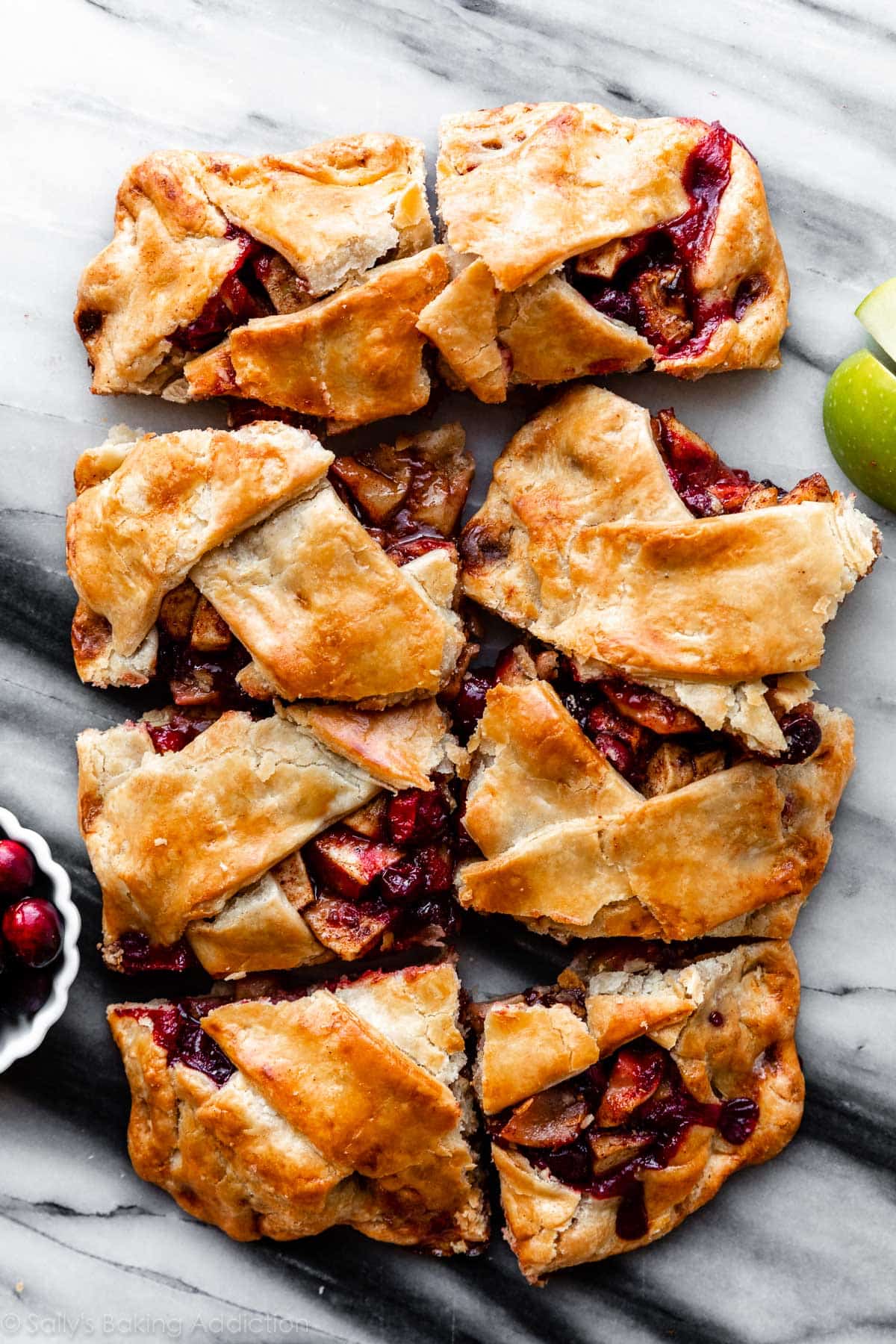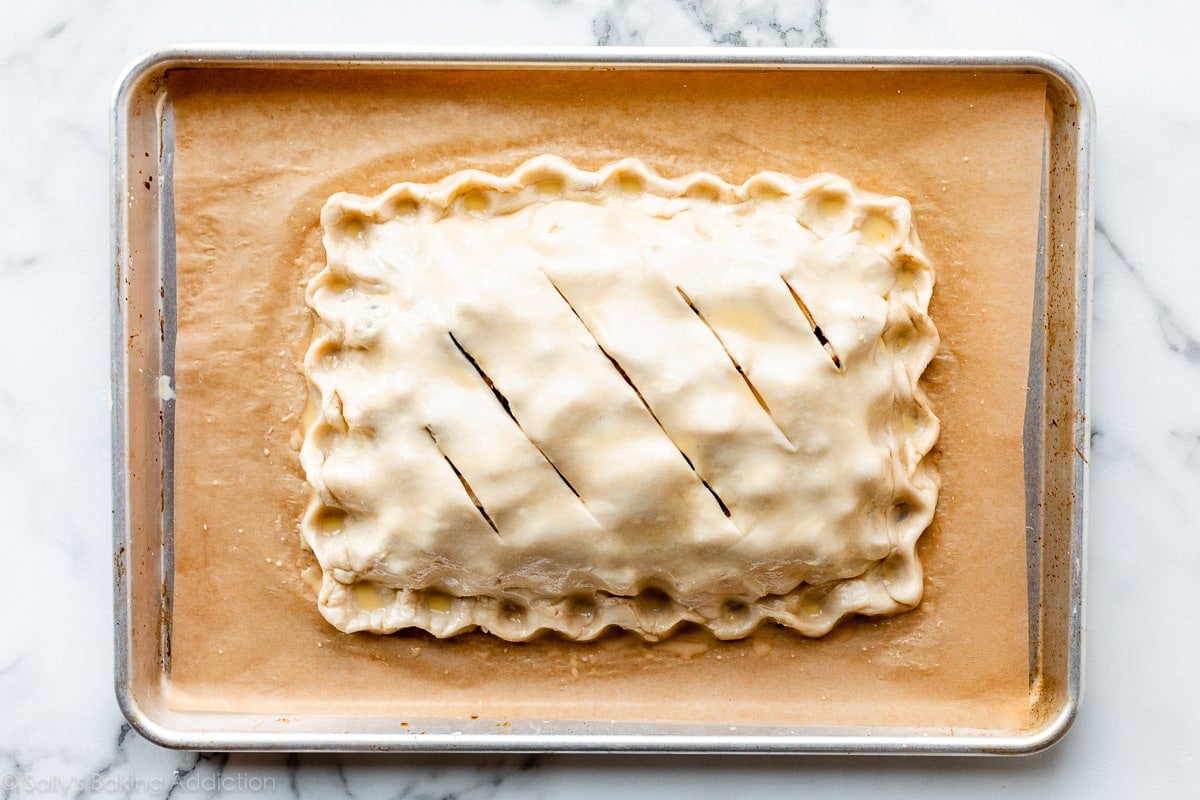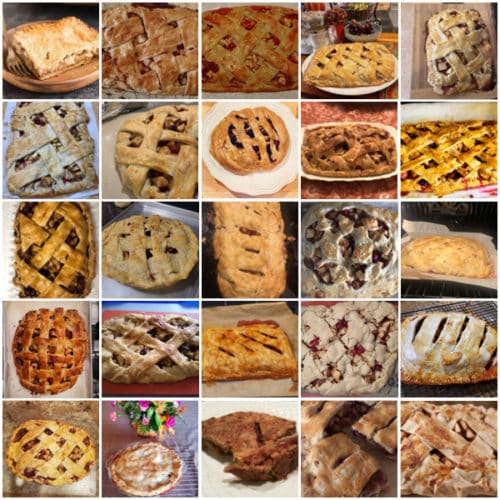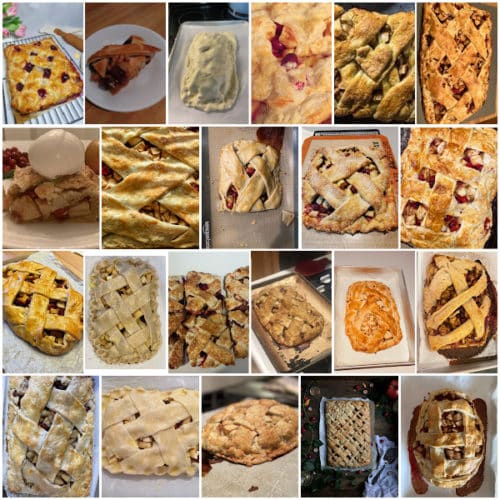This cranberry apple slab pie is a smaller version of traditional slab pie. Baked free-form style on a baking sheet, this flatter pie barely has to cool before digging in! Juicy sweet cinnamon apples and tart cranberries taste fantastic with a buttery flaky golden pie crust. You need 2 crusts and you can use your favorite or store-bought version, but I encourage you to try my beloved pie crust recipe.

I don’t say this a lot but here goes nothing: sometimes it’s ok to break the baking rules!! And we’re definitely doing that today with this pie. This is a free-form style pie with no boundaries. 😉 Just make sure the top and bottom crusts are rolled thin enough and secured/pinched together to prevent excess leaking.
We’re basically making a giant pop-tart that’s welcome alongside your Thanksgiving pies. Might I add, it’s much easier to make than traditional apple pie, too.
Why You Will Love This Cranberry Apple Slab Pie
- Smaller version of a traditionally large slab pie—serves 8.
- Slab pie is cut into bars/rectangles so it’s easy to slice, serve, and freeze.
- It’s shallow, so there’s no need to fully cool before slicing and serving.
- No par-baking the bottom crust.
- Altogether flaky, buttery, sweet, tart, fruity, and spiced! If a scoop of sweet and tart cranberry sauce is a must on your Thanksgiving plate, you’ll love the pop of flavor that cranberries add in this slab pie.
- Or you can swap cranberries for more apples or another fruit.
I suppose you could say this is like my apple galette, only a bit thicker and with a top crust. And it’s a smaller version of this apple slab pie and includes cranberries. It’s really just… its own special thing!


Pie Dough
You can use your favorite pie crust recipe, but I encourage you to try mine. You need the full pie crust recipe, which makes 2 crusts. (1 for bottom of pie, 1 for top of pie.) I use a mix of shortening and butter because they work together to make the BEST crust. Butter adds flavor and flakiness, while shortening helps the dough stay pliable which is helpful when you’re rolling and shaping it. Plus, its high melting point is advantageous because it helps the crust stay tender while still maintaining shape. It’s the same crust I use for my pumpkin pie and pecan pie, too.
If you don’t want to use shortening, try my all butter pie crust recipe instead—it also yields 2 crusts.
3 Success Tips
- Keep the Filling Compact: You don’t want many air pockets in the filling, so do your best to pile the filling tightly onto the bottom pie crust. This filling recipe yields a lot and keeping it compact ensures it will all fit!
- Bake On Sheet Pan: This is a free-form style pie baked on a large baking sheet with extra room to spare. It’s best to bake this pie on a half sheet pan, preferably one with rimmed sides. None of my test pies leaked enough juices to reach the edge of the pan, but if you don’t have a tight seal on the pie dough edges, the juices could certainly spill over. If you need a recommendation, I use and love (affiliate link) these half sheet pans.
- Tight Seal on Edges: Cranberries leak a lot of juice, so tightly seal the dough edges as best you can. Plus, since this pie doesn’t reach the edges of a half sheet pan, it essentially has no structure support! Seal those edges by crimping them with a fork or fluting with your hands. (You can watch me flute the edges in the video below, or see my full tutorial on how to crimp and flute pie crust.) If the pie dough becomes too warm and fluting/crimping is impossible, stop and refrigerate the pie for 10-15 minutes before trying again. The refrigerator is pie dough’s best friend.
Can I Bake This in a 9×13 Inch Pan?
You can, but the best option is a quarter sheet pan like this quarter sheet pan. The pie will take up the entire size of the pan, much like the full size apple slab pie takes up an entire half sheet pan. The lower sides help make sealing the pie dough edges a little easier. If you have and want to use a regular metal or glass 9×13-inch dish, you absolutely can! Avoid ceramic because the bottom crust will not cook through completely.
Step-by-step photos below the recipe!

Tested Variations You Can Try
- Only Apples: It’s easy to leave out the cranberries if you want plain apple slab pie. Replace with 1 more cup of chopped apples. Feel free to skip the orange zest and replace with lemon zest for a bit of fresh flavor.
- Substitute Cranberries: Instead of replacing the cranberries with more apples, try 1 cup fresh or frozen blueberries, cherries, blackberries, or sliced pears.
- Lattice Top: The video tutorial below shows a lattice topping for this cranberry apple slab pie. My 6 pie dough strips are about 2 inches wide, but feel free to cut your strips thinner so you can use more. If you’re new to lattice, here’s my how to lattice pie crust tutorial. I also have directions in the recipe below.
- Full Crust Top: If you’d rather skip the lattice crust and use a full top crust, you can find those instructions below as well. (And photos below the recipe!)
- Larger Size: For a full size slab pie (the total size of a half sheet pan), I recommend following the crust and filling for this apple slab pie. Replace 1 and 1/2 cups of the apples with fresh or frozen cranberries. Feel free to add some orange zest and/or skip the icing.
- Regular Pie: Want these same flavors but in a regular pie dish? Here’s my apple cranberry pie recipe—it has slightly more filling to fit into a pie dish.

What Are the Best Apples to Use for Baking?
Firmer apples are ideal for baking so avoid soft, mealy, and mushy apples. And when a recipe calls for more than 1 or 2 apples, like today’s slab pie, apple crisp, or this apple crumble pie, it’s best to use a mix of tart apples and sweet apples.
- Tart apples for baking: Granny Smith (my absolute favorite apple for baking), Braeburn, Jonathan, and Pacific Rose
- Sweet apples for baking: Jazz, Honeycrisp, Pink Lady, and Fuji
For a detailed list of my favorite apple varieties, and when to use each, you can visit my post The Best Apples for Baking.
See Your Cranberry Apple Slab Pies!
Many readers tried this recipe as part of a baking challenge! Feel free to email or share your recipe photos with us on social media. 🙂
Print
Cranberry Apple Slab Pie (Small Version)
- Prep Time: 3 hours
- Cook Time: 55 minutes
- Total Time: 4 hours
- Yield: serves 8
- Category: Dessert
- Method: Baking
- Cuisine: American
Description
Baked free-form style on a baking sheet, this juicy, sweet, and tart cranberry apple slab pie barely has to cool before digging in! You need 2 crusts and you can use your favorite or store-bought version, but I encourage you to try either linked pie crust recipe below. Review recipe notes and watch the video tutorial before starting.
Ingredients
Crust
- Homemade Pie Crust or All Butter Pie Crust (both recipes make 2 crusts, 1 for bottom and 1 for top)
- extra all-purpose flour for work surface, hands, and rolling pin
- egg wash: 1 large egg beaten with 1 Tablespoon (15ml) milk
Filling
- 5 cups (about 600g) peeled and chopped apples (chunks that are 1/4 – 1/2 inch thick)*
- 1 cup (110g) fresh or frozen cranberries (do not thaw)
- 1/2 cup (100g) granulated sugar
- 2 Tablespoons (14g) cornstarch
- 1/2 teaspoon orange zest
- 1 teaspoon ground cinnamon
- 1/4 teaspoon ground allspice
- 1/4 teaspoon ground nutmeg
- 1 Tablespoon (14g) cold unsalted butter, cut into small cubes
Instructions
- The crust: Prepare either pie crust recipe through step 5.
- The filling: In a large mixing bowl, stir the apples, cranberries, sugar, cornstarch, orange zest, cinnamon, allspice, and nutmeg together until combined. Set aside as you roll out the bottom pie crust. (Butter is used in step 5.)
- Line a half sheet pan with parchment paper or a silicone baking mat. Set aside. Make sure you have enough room in your refrigerator for the pan because the assembled pie must chill for at least 15 minutes before baking.
- Roll out the chilled pie dough for bottom crust: Remove 1 disc of pie dough from the refrigerator. Keep the other in the refrigerator until you’re ready for the top crust. On a lightly floured work surface using a lightly floured rolling pin, begin rolling the dough out into a rectangle. Make sure to turn the dough about a quarter turn after every few rolls and to really ensure the dough isn’t sticking to the work surface, flip it over a few times during this process. Keep everything lightly floured. I find anywhere around a 10×14 inch rectangle is great. Dough should be about 1/8-inch thick. Tip: Your hands are your best tool in this step. Use your hands and fingers to smooth cracking edges and keep the sides straight. You can watch me do this in the video. Carefully transfer the rolled out dough to the lined pan.
- Add filling & fold dough edges: Using a spoon or your hands, tightly pile the filling onto the rolled out pie dough leaving a 1.5 inch border around the edges. Keep filling tight and compact to minimize air pockets. Discard any leftover juices in the filling bowl. Dot the pieces of butter on top of the filling. Fold dough edges over filling and pinch edges.
- Roll out 2nd chilled pie dough for top crust: For a lattice top as shown in the video, roll out pie dough into a large oval, about 1/8 inch thick. (Exact dimension doesn’t matter, but thickness does). Using a sharp knife or pizza cutter, cut 6 2-inch strips of dough. See video starting at 3:35 for a visual of the following lattice weaving—lay 3 strips diagonally and evenly spaced on top of the filling. Use a longer strip in the center of the pie and shorter strips on the ends. Fold center strip back. Place 4th strip diagonally in opposite direction over the end strips and under the center strip. Fold center strip back over 4th strip. Fold end strips back. Lay 5th strip in opposite direction on top. Unfold the 2 strips back so they lay over the 5th strip. Fold bottom center strip back. Place last strip in opposite direction over end strips and under center strip. Fold center strip back on top. For a full crust top as shown in photos below, roll out pie dough into the same size rectangle as the bottom crust, about 10×14 inches. Drape over filling.
- Seal edges: If you have excess top crust dough that lays over the bottom dough edges, no need to trim it. Instead, fold the excess dough back to make a thicker edge and pinch together with the bottom pie dough to seal. Flute the edges with your fingers or crimp with a fork. If edges aren’t sealing well and fluting or crimping is too difficult, the dough may be too warm at this point. Stop what you are doing and refrigerate the pie for 10-15 minutes then try again. (Review my how to crimp and flute pie crust tutorial if you need extra help with this step.)
- Egg wash: Brush the pie dough with egg wash. If you used a full top crust (not lattice), use a sharp knife to cut 3-5 slits in the top crust for air vents. Refrigerate pie uncovered for 15 minutes as oven preheats. (Or refrigerate up to 1 day. Cover lightly if refrigerating longer than 15 minutes.)
- Preheat oven to 375°F (190°C).
- Bake pie for 45-55 minutes or until the top crust is golden brown and the filling’s juices have been bubbling up through the lattice/vents for at least 5 minutes.
- Remove pie from the oven and cool for 5 minutes before slicing and serving.
- Cover leftovers tightly and store in the refrigerator for up to 5 days.
Notes
- Make Ahead / Freezing Instructions: There are a couple ways to make this pie ahead of time. Assemble the pie through step 8 and refrigerate assembled pie for up to 1 day. Or assemble and bake the pie 1 day in advance—after pie cools, cover tightly and keep at room temperature. The pie crust dough can also be prepared ahead of time and stored in the refrigerator for up to 5 days or in the freezer for up to 3 months. Baked and cooled pie also freezes well for up to 3 months. Thaw overnight in the refrigerator and allow to come to room temperature before serving. (Feel free to warm the slices in the microwave.)
- Special Tools (affiliate links): Apple Peeler | Zester | Glass Mixing Bowl | Rolling Pin | Rimmed Half Sheet Pan | Silicone Baking Mat or Parchment Paper) | Pastry Brush | Pizza Cutter
- Apples: You need 3-4 medium apples. I recommend a mix of tart and sweet apples—I like using Granny Smith and Honeycrisp.
- Chilling Assembled Pie Before Baking: Chilling the shaped pie in the refrigerator before baking helps it maintain shape in the oven. Remember, cold pie dough is always best. I usually refrigerate the assembled pie for 15 minutes as the oven preheats. If you’re nervous to chill the baking sheet in the refrigerator then bake it (which can cause warping), after chilling it, you can very slowly and carefully lift the parchment/baking mat as a whole—with the chilled pie on top—and place it all on another (not cold) baking sheet to bake.
Let Me Show You a Few Steps
For the filling, I recommend cutting the apples into chunks instead of slices. Since slab pie is thinner than regular pie, you can’t really layer the slices together to get enough apple in each bite. 1-inch chunks that are between 1/4- and 1/2-inch thick are ideal for this pie.

Set filling aside as you work on the bottom crust.

Tightly pile the filling on top leaving a 1.5-inch border around the edges. Dot with small pieces of butter. (I forgot to take a picture of the filling with butter on top but you can see me add it in the video.)

Now it’s time to decide how you want to top your slab pie—do you want a full top crust, a lattice top, or other decorative pie crust design? Or do you want to know how to braid pie crust? I’m showing you two versions in the following photos and you can find instructions for both in the recipe above.
Full Top Crust:
Don’t forget to cut slits in the top for air vents.


Lattice Top Crust:
A little more challenging, but doable! As you can see in the video above, I do not trim excess pie dough from the edges. I like folding excess dough back onto the edges of the pie so there’s more dough to work with when crimping or fluting the pie crust. If you ever need help with pie dough edges, you can see me do this up-close in the how to lattice pie crust video starting at the 1:59 mark.








































I’ve enjoyed trying out your recipes while I’m on maternity leave. This one is one of my favorites so far!
has anyone put cheddar in the crust and if yes how much?
Could I use this recipe to make hand pies?
Sure can, Trice! You can follow the assembly and baking instructions for these hand pies.
I have a cottage bakery, and I love your recipes! I’m planning to make this in a 9×13 glass dish to take to a party. If I roll the crust to fill the pan, do I need to line it with parchment first? Thanks!
Hi Kathy, it should be fine without parchment in a glass dish, but you can certainly still use a sheet of parchment paper to ensure super easy slicing and removal!
Could you cook the filling partially prior to soften the apples?
Hi Michele, we don’t find it necessary but you can if desired.
Fantastic! I love this recipe! It looks impressive and tastes wonderful. Easy to make too! A keeper!